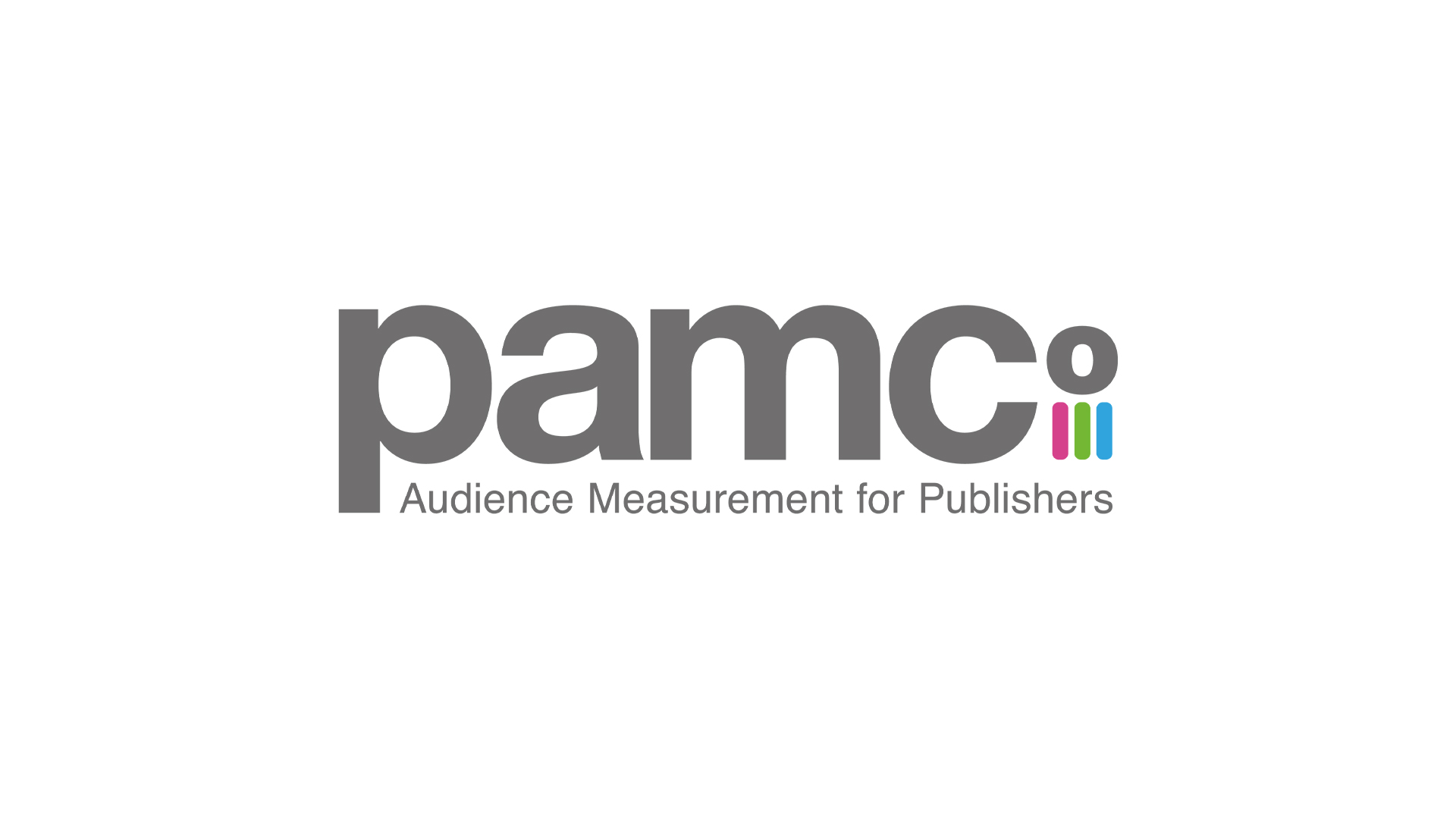PAMCo FAQs
- What is PAMCo – Audience Measurement for Publishers?
PAMCo – Audience Measurement for Publishers is the new audience measurement currency for published media. It produces de-duplicated brand reach allowing users to carry out reach & frequency planning and also plan and trade audiences across all the platforms on which published media content is delivered – phone, tablet, desktop and print.
The new PAMCo currency is platform neutral and provides the following:
- De-duplicated reach and frequency for all platforms: Phone, Tablet, Desktop and Print
- An increased number of brands reported across all platforms
- Single source data to understand duplication between print and digital
- Improved estimates of net brand reach and duplication
- Reporting newsbrand sections across print AND digital
- New engagement data
- How does PAMCo measure published media audiences?
PAMCo’s world-leading methodology integrates data from three sources to provide a complete view of publisher audiences.
- A high-quality face to face survey of 35,000 participants per year interviewed in home to collect print readership and demographic data.
- A digital panel of around 5,000 participants (recruited from the survey participants at the time of interview) to have a specially designed Tracker App installed on their devices i.e. desktop, laptop, phone, tablet.
- A new specially developed data file from comScore, UKOM’s chosen digital audience supplier, which makes it possible to integrate fully ‘phone and tablet audiences as well as pc/laptop audiences.
- Why is PAMCo incorporating comScore’s digital estimates?
PAMCo incorporates comScore’s estimates for digital platforms, rather than issue its own estimates because Published media wish to have a level playing field with all other digital brands in the universe.
- Are the PAMCo digital audience estimates the same as those comScore publish?
The data integration procedure is designed to match comScore’s published estimates as closely as possible.
Users will, however, notice some differences due to universe definition. PAMCO’s universe is Great Britain age 15+, while comScore’s is United Kingdom age 6+ for home desktop/laptop and 18+ for mobile and work desktop/laptop. Ipsos therefore make adjustments to remove those visitors who are either based in Northern Ireland or aged 6-14, and model in estimates for mobile visitors aged 15-17, as well as other procedures necessary to align the PAMCo and comScore datasets.
A tolerance is then set that PAMCo estimates should be within 5% of the target comScore estimates, though they are usually well within that.
- Will the PAMCo audience numbers be comparable to NRS estimates?
No, the audience estimates will not be directly comparable with NRS. There are many changes which mean that it will not be possible to make direct comparisons for commercial purposes, and the PAMCo data are in effect a brand-new dataset. For instance, changes to the readership questions include the introduction of a ‘brand-first’ questionnaire structure.
- How does PAMCo methodology compare to other readership measurement currencies around the world?
PAMCo has the first all-device Panel we are aware of.
- What is the PAMCo universe?
PAMCo represents a universe of adults aged 15+, living in Great Britain. The weighted universe is 52,748,000 adults for 2017.
- Will more brands have estimates reported than was the case for NRS?
Yes. For digital, we are expecting around 100 publisher brands to have estimates included across all platforms, a considerable increase on NRS.
In addition to the 170 print brands measured by NRS, PAMCo will include estimates for around 50 additional newspaper supplements and in-paper sections.
Around 350 non-publisher brands will also have digital estimates included in the dataset (e.g. large advertiser websites), so that they can be analysed alongside the publisher brands.
- What is Total Brand Reach?
Total Brand Reach (TBR) is the measure used in the PAMCo published tables. The definition has been agreed by the PAMCo Board.
TBR is a measure reach of all related content for each publisher brand and includes:
- Related/sub-brands that share the main title branding or url of the parent brand e.g. The Guardian and www.the guardian.com.
- Related and sub-brands that display the parent branding on the home page of the website/app.
- Sunday papers that do not share weekday branding (e.g. The Observer), to keep parity with other brands.
Non-publisher websites, including store/retailer/membership websites will not be included in TBR definitions but could be part of the overall PAMCo dataset.
- Will PAMCo include separate estimates for third party platforms such as FBIA, Google AMP, Snapchat, Apple News, Google newsstand, Daily Hunt?
comScore can include measurements for some of these platforms, currently FBIA, Google AMP, Apple News, Flipboard and Google Newsstand. Where publishers have the appropriate tagging in place traffic via these platforms will then be included in their overall digital estimates within PAMCO.
However, due to the way data relating to third-party platforms are collected, comScore are not able to supply Ipsos with the ‘respondent-level data’ which would be required to break out estimates for third-party platforms in the PAMCo database. In the interests of transparency, the PAMCo Board have therefore agreed publishers will be asked to identify whether or not their comScore estimates include traffic from third-party platforms. This will be indicated by a symbol D contained in the name of the publication so it is immediately visible to users when using any analysis system or published tables.
It remains a key development objective to be able to break out third-party platform estimates within the PAMCo dataset, so that their contribution to the overall digital estimate is clear and users have maximum flexibility as to which platforms to plan on. PAMCo and Ipsos will be working with comScore and the other industry bodies concerned towards this end.
- How can I access PAMCo data?
You can access PAMCo data in 3 different ways:
- Topline audience estimates are available through the PAMCo website
- More detailed analysis can be carried out through computer planning bureaux, such as Kantar Media, Nielsen IMS, Telmar, as well as Mediatel and Touchpoints.
- There is also an opportunity to obtain direct access to respondent-level data to feed into publisher and agency proprietary tools.
- What is new in the PAMCO Questionnaire?
- What data are included about digital readers?
The data incorporated from comScore are:
- Daily, weekly and monthly reach (Unique Visitors) by platform
- Page views by platform. (Desktop video views are also included)
- Time spent by platform
- Content sections (where published by comScore, usually for the newsbrands). It will be possible to analyse these digital sections individually and by 11 content categories: News, Homepage, Sport, Lifestyle, Arts & Entertainments, Personal Finance, Business, Science & Technology, Travel, Jobs/Careers, and Motors).
- When will I be able to trend my data?
Due to the different methodologies between NRS and PAMCo data the PAMCo Board have mandated that they should not be compared for marketing and commercial purposes. As such, you will not be able to trend data until such time as there are at least two PAMCo datasets to compare and trend.
- When is the next data release?
| Data Period | Release Date | Embargoed Until | |
|---|---|---|---|
| PAMCo 1 2018 | Jan ’17 – Dec ’17 (Nov ’17 comScore data) | 9th April 2018 | 08:59am 19th April 2018 |
| PAMCo 2 2018 | Apr ’17 – Mar ’18 (Feb ’18 comScore data) | 11th June 2018 | 08:59am 18th June 2018 (tbc) |
| PAMCo 3 2018 | Jul ’17 – June ’18 (May ’18 comScore data) | 10th September 2018 (tbc) | 08:59am 17th September 2018 (tbc) |
| PAMCo 4 2018 | Oct ’17 – Sep ’18 (Sep ’18 comScore data) | 10th December 2018 (tbc) |
*PAMCo Client Services is dedicated to helping all of our clients use PAMCo data to its full potential. For detail on our training overview and how to book, please click here.


